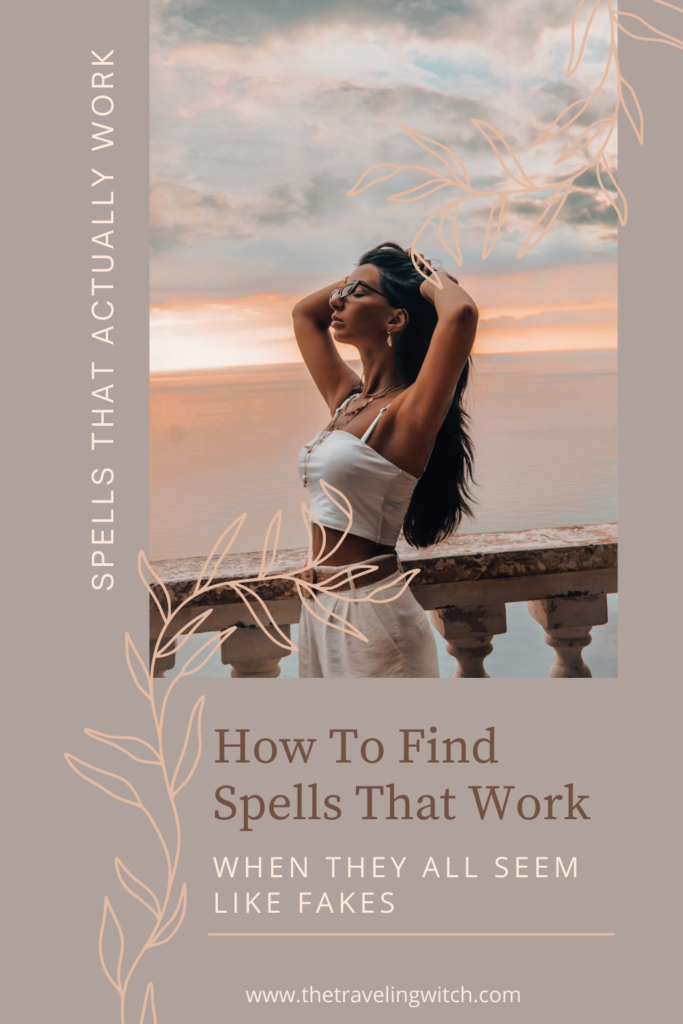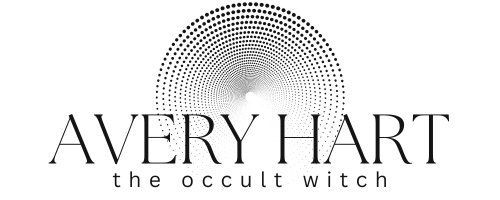Finding spells that actually work can be a struggle. There’s so much information available, so many resources, and so many websites claiming to have spells for beginners that it can be borderline impossible to figure out what’s real and what’s fake. And this might seem like a problem that only affects new witches, but I’ve even heard more experienced witches complaining about the difficulty of finding good spells in today’s oversaturated environment. And if you are a beginner? Forget about it. For every one good spell you find, you’re likely to end up with 10 complete duds without being able to tell the difference between them.

This can be so frustrating and demoralizing. I’ve watched witches search for weeks trying to find a single spell that would work, not because they couldn’t find a spell, but because they didn’t know how to tell when they had the right one. No more! Today we’re going to talk about how you can find spells that actually work and how to tell the difference between an effective spell and a fake.
Why Is It So Hard To Tell Good Spells From Duds?
There are many reasons it can be so difficult to find good spells nowadays, but the heart of the matter is really that there’s just way more information available to us than there ever has been at any point in the past. Our ancestors did not have access to huge numbers of books about witchcraft, more websites than a person could ever hope to read, and advertisers trying to capitalize on the latest witchcraft trend. They had whatever witchcraft they could learn from their friends, their neighbors, or their family. They might have had access to a single spellbook, but even that was unlikely since much of this information was never written down because of the danger inherent in being a practicing witch. They never had to worry about whether the spells worked because if they had been taught the spell, the other witches in their life and their family lineage had already verified that the spell worked. Hell, most spells were probably tweaked and improved over many generations, creating incredibly effective magic that could be passed down from person to person.
We no longer have access to this kind of certainty or reliability when learning the craft. In reality, most of us are learning the craft by ourselves, through self-education, hoping that we stumble across the right information. Learning this way takes forever, and it can be so frustrating and confusing. This is the entire reason why I started The Coven! I was tired of watching my fellow witches floundering as they tried to get their bearings and parse through the massively overwhelming amount of information that was available to them. I wanted to teach witchcraft in a way that was straightforward, easy to understand, and that led to good results.
The truth is, lots of people teach witchcraft, but not many people can teach you how to learn witchcraft. There are skills inherent in the craft that we seldom talk about and we certainly don’t go out of our way to teach them. They’ll teach you how to use herbs in witchcraft, but they won’t teach you how to substitute herbs or how to connect with the herbs on a spiritual level so that you can further your craft through that vital energetic relationship. They’ll teach you to work magic, but they won’t teach you the magical theory behind the actions you’re taking. They’ll teach you how to cast spells, but they won’t teach you how to find the spells that actually work.
Of course, it’s hard for you to figure out which spells actually work! You’ve never been taught the skillset that you need to identify effective spells. It’s time to change that!
How To Tell If A Spell Actually Works
There are many reasons why I spell might work or might not work. These range from simple magical mechanics all the way to personal technique and preferences. When you’re looking for good spells, you have to take all of these aspects into account. While this might seem like a lot to keep track of right now, it becomes exponentially easier to identify the spells that meet these criteria as you gain experience. Eventually, this skill will become so second nature you won’t even have to think about it consciously. Here are the five criteria that I use when evaluating new spells to make sure that I’m choosing the spells that will work best.
1. The goal of the spell is actually possible
This might seem obvious to some of you, but a lot of new witches don’t realize where the boundaries are as far as what witchcraft can actually accomplish. Because witchcraft does have boundaries! We cannot achieve the impossible through witchcraft, no matter how much we might like to, no matter how many incantations we use, no matter how good the spell is that we find. If the goal of the spell is impossible, then the spell has no hope of working. For example, magic cannot break the rules of physics. Magic functions within our physical reality and so it has to obey the laws of the physical reality that we live in. You cannot transform yourself into a wolf. It’s just not physically possible. That spell to change your eye color also won’t work because color is a complex mechanism that relies on the interplay between light and matter. Altering that interplay just isn’t going to happen!
You can also rule out any spell that, while technically possible, is so unlikely as to be functionally impossible. This would be something like winning the lottery. While yes, it’s technically possible for you to win the lottery, your odds are about 1 in 229,200,000. You have a higher likelihood of being struck by lightning (1 in 12,000), being hit by a meteorite (1 in 700,000), or being canonized as a saint by the Catholic Church (1 in 20,000,000). Fighting those odds is a losing battle, no matter how much magic you throw at it.
Stick to spells with goals that are actually within the realm of possibility! Do you want more money? Try a spell to get a raise at work for a spell to get a higher-paying job. Do you want to fall in love? Try a spell that will draw someone into your life who’s perfect for you. Stop focusing on things that are impossible and start finding ways that you can make your life better in real, tangible ways.
2. The spell uses well-established techniques and methods
This is actually a kind of shortcut for when you haven’t sat down to learn the intricacies of magical theory. Magical theory is a very complex field of study and not every witch wants or needs to dive deeply into it. If you’re not there yet or magical theory just isn’t for you, you’ll want to stick to spell casting techniques and methods that are well established. What does this mean? Essentially, it means looking for common actions or techniques that occur in many spells. For example, a candle spell is a very common magical technique. Poppet magic has a long history of use in witchcraft. Magic using herbs is quite common. By contrast, a spell that uses plastic glitter has much less history and tradition backing up its efficacy than, say, a spell that uses herbs.
This isn’t to say that new forms of spell casting are never successful, but if you’re looking for spells with a higher likelihood of success, sticking to tried-and-true methods can prove useful. It can also be very useful to learn the reasons behind various techniques and methods so that when you see them in spells, you can judge for yourself whether they suit the magic being performed. For example, does it make sense for a spell to improve a relationship to involve burning a photo of that person? Does it make sense for a spell meant to manifest good things in your life to involve flushing something down the toilet? If you’re casting a spell to get a better job, does it make sense for that spell to end up in the freezer? Look for the lines of logic that link your intent to the actions being taken. If the methods or techniques being used in the spell seem to contradict the intent of the spell, that’s a red flag. Always look for spells that have a clear line of logic connecting the intent and the method.
3. The spell fits your spellcasting style and preferences
Personal preference and abilities are huge when it comes to the success of your spell work. You can be the best spell caster in the world, but if you’re working a type of spell that directly contradicts your preferences and abilities, the likelihood of that spell working drops dramatically. A big part of progressing in your witchcraft is learning what you are and are not good at, what types of magic work for you and what types do not, and finding the correct energies that will produce the desired effect when combined with your energy. People forget about this a lot! Just like a plant has an individual energy, or a crystal has a particular energy, human beings each have an individual energy signature. And just like with stones or herbs, sometimes your energy signature will not play well with other energies. It’s up to you to find the energies that work well with your individual energy signature. As an example, I cannot work with basil in my spell work. Something about my energy and the energy of basil just does not mix. Any spell that I put basil into will fail, guaranteed.
Take the time to notice when otherwise well-formulated spells fail for you. I suggest every time you have a spell fail, take notes on what happened and make sure that you set that particular spell aside so that you have it for later reference. Over time, you will collect a selection of spells that have failed for you, and you can sit down with these and find the common denominators between them. You will be able to see the patterns when you look at all of these spells together and notice if perhaps, for example, 80% of them are potions or several of them involve hyssop. These patterns will help to show you exactly what to avoid in future spells if you want to avoid spell failure.
Likewise, you can do the opposite as well. When a spell works very well for you, take notes on it and put that spell aside. Over time, you will collect many spells that work very well for you. This is useful because now you have a solid bank of spells to pull from any time you need one, but also because it allows you to see the patterns present in spells that work very well for you.
4. The ingredients actually align with your goals
In the same way that the methods and techniques of a spell should align with the intent of the spell, the ingredients used in the spell should align with the intended goal. Take a moment to figure out why each ingredient is being used in the spell. These are often the biggest red flags for a poorly formulated spell. For example, if I see a curse or a banishing spell that involves lemon, I’m probably not going to use that spell. For me, lemon is a plant that evokes a sense of joy, happiness, love, all of those fun, exuberant, summary feelings. It might be that for some people, the acidic nature of the lemon does evoke a more defensive or aggressive energy, but I could never use it in that context successfully.
You might notice here that I’m talking about my personal associations with this plant. This is super important. You can reference all the correspondence lists and charts that you want. You will almost always find contradictions and disagreements about what a plant actually does. This is why I recommend not relying on correspondence lists! Ask yourself what a particular plant means to you. What context have you used it in before, both magical and non-magical? What do you associate this plant with? What do you notice this plant being used for the most in spells that you know are well formulated?
That final question is also an important consideration. You may know that Rosemary is commonly used as a plant in love spells, but you may notice that it’s most often used in spells that are designed to improve fidelity, harmony, and peace in long-term relationships. If you find Rosemary in a spell to attract a fiery, passionate fling, that’s a poorly formulated spell. Building up the necessary knowledge to be able to understand these kinds of interactions easily does take time, so don’t worry if you’re not sure which ingredients belong where just yet. When you’re looking for spells, take the time to research the ingredients being used and over time you will develop a sense for what ingredients belong where.
5. The spell comes from a reliable resource
Finally, sticking to spells that come from reliable resources is never a bad plan. When you find a really good resource that you trust, they should be your first stop. This might be an author that you like, a blogger who seems to know their stuff, a particular book that seems to get really good results for you, etc. When it comes to finding these reliable resources, I would stick to resources that are created by people who are consistent in their teachings, who are transparent about where their information comes from and where their expertise comes from, and who you’re pretty sure are real people and not some ghostwriter churning out words for money. It’s also worth checking out what other people are saying about a particular resource and whether other witches, especially more experienced witches, consider that resource to be reliable. When you find a resource that you really like, hang on to it. These are pure gold in our oversaturated internet world.
When it comes down to it, deciphering which spells work and which don’t is a skill that takes time and experience to develop. It’s ok if you find yourself occasionally casting spells that flop. It happens to everybody! Spell failure is a totally normal part of learning witchcraft and it doesn’t mean that you’re bad at witchcraft, it just means that you’re still learning! If you’re looking for a way to beat the information overload and streamline your learning process, The Coven gives you access to 55 witchcraft classes on a broad range of topics, the Q&A podcast, monthly rituals, and a thriving community of witches just like you. You can learn about clearing money blocks in our Money Magic course, learn to create a magical home with the Domestic Witchcraft course, learn about divination, herbalism, spirit work, and so much more all in one place. Classes range from absolute beginner to advanced witchcraft and can help you progress your magical skills no matter where you are right now.
Sign up for The Coven today and let’s take your craft to the next level together. >>
Struggling with your magic?
Take the Quiz to Discover Your #1 Witchcraft Obstacle

Updated on June 18, 2024 by Avery Hart




we do still have initiatory traditions that have generations of teachers and students, whether blood related or not, who have used the workings that are taught. it’s less common than people learning on their own for sure, but it does still exist.
Definitely! Much of what I know has been learned from mentors who have a solid lineage like this but a lot of the students I work with don’t have access to those kinds of teachers so I try to make sure they have the right learning resources to make their magic work.